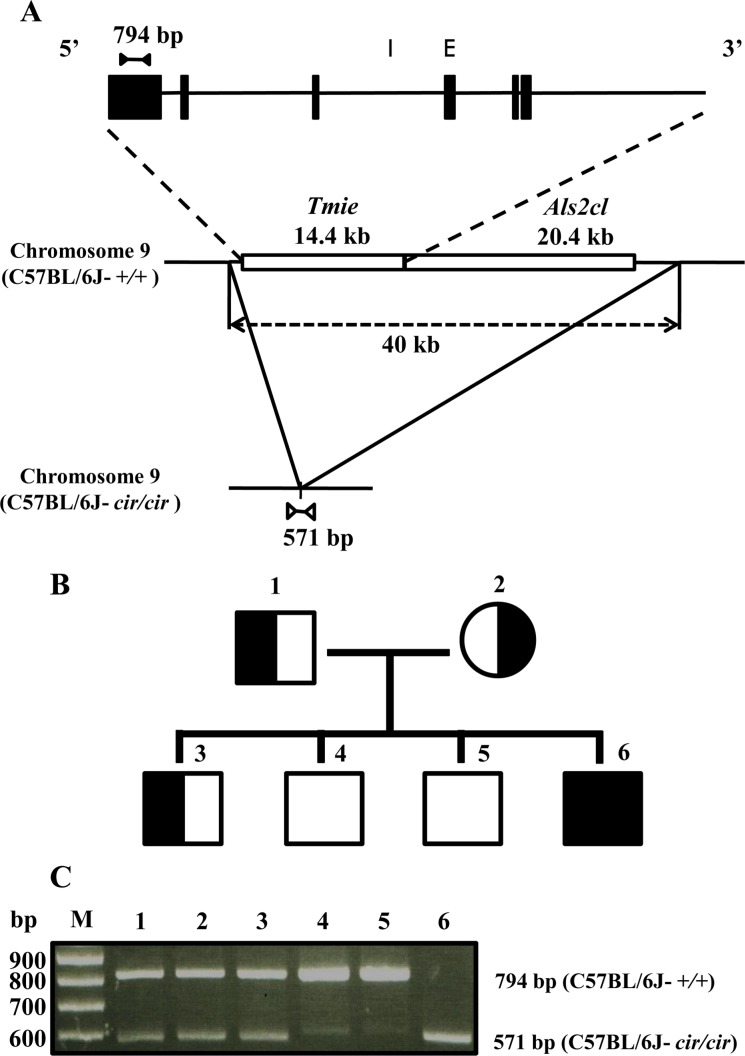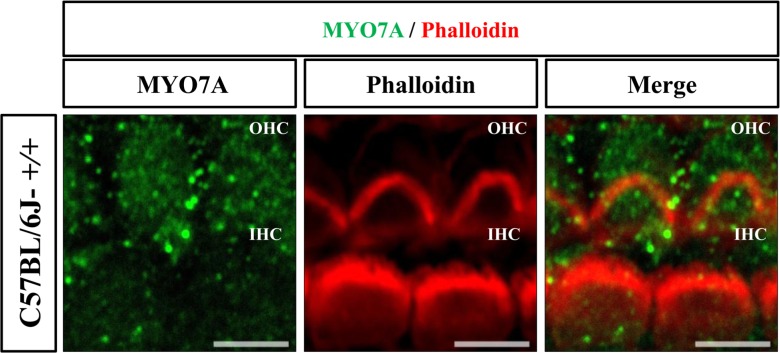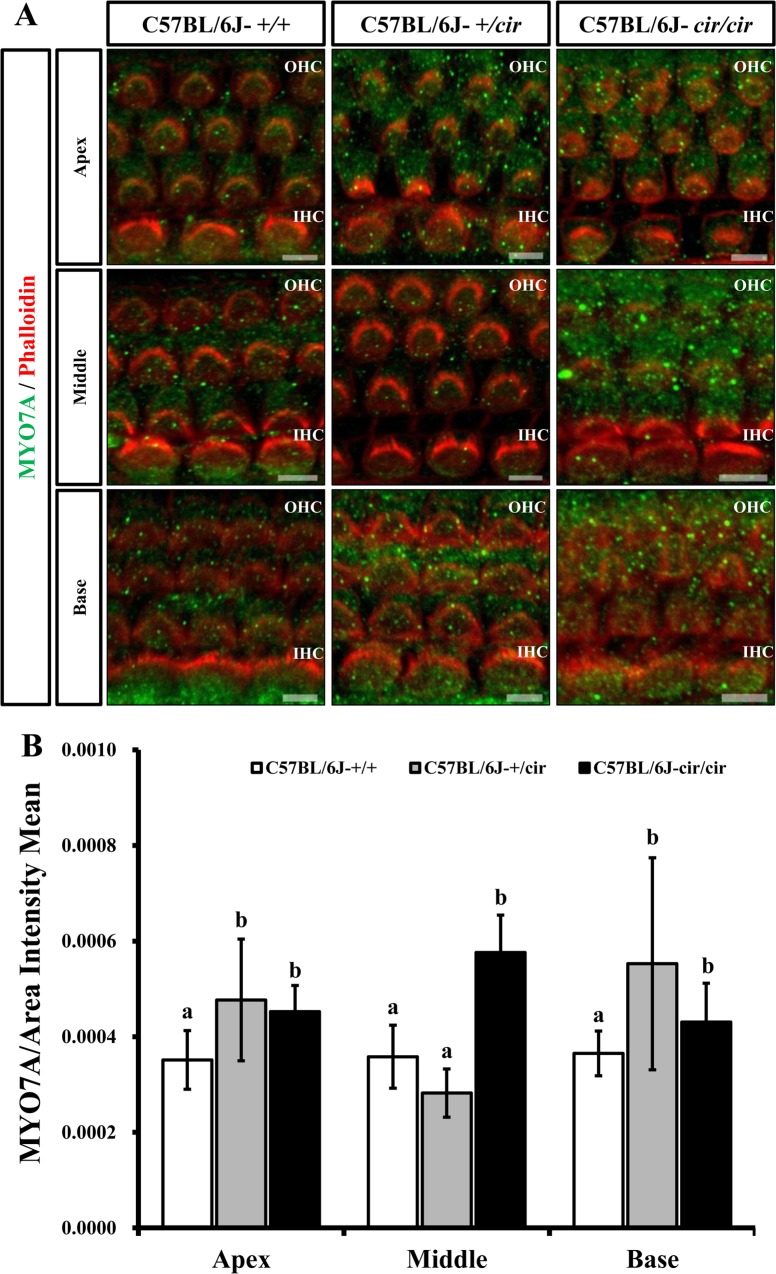Lab Anim Res.
2017 Mar;33(1):1-7. 10.5625/lar.2017.33.1.1.
Over-expression of myosin7A in cochlear hair cells of circling mice
- Affiliations
-
- 1Department of Medical Genetics, College of Medicine, Hallym University, Chuncheon, Korea. jgsuh@hallym.ac.kr
- KMID: 2375266
- DOI: http://doi.org/10.5625/lar.2017.33.1.1
Abstract
- Circling mouse (C57BL/6J-cir/cir) deleted the transmembrane inner ear (Tmie) gene is an animal model for human non-syndromic recessive deafness, DFNB6. In circling mouse, hair cells in the cochlea have degenerated and hair bundles have become irregularity as time goes on. Tmie protein carries out a function of the mechanoelectrical transduction channel in cochlear hair cells. Myosin7a (MYO7A) protein has key roles in development of the cochlear hair bundles as well as in the function of cochlear hair cells. To find whether Tmie protein interacts with MYO7A proteins in the cochlea postnatal developmental stage, we investigated expression of the MYO7A proteins in the cochlear hair cells of circling mice by western blot analysis and whole mount immunofluorescence at postnatal day 5 (P5). The expression of MYO7A showed statistically significant increase in the cochlea of C57BL/6J-+/cir and C57BL/6J-cir/cir mice than that of C57BL/6J-+/+ mice. The MYO7A intensity of the cochlear hair cells also increased in C57BL/6J-+/cir and C57BL/6J-cir/cir mice compared with those of C57BL/6J-+/+ mice. Taken together, the results indicate that Tmie protein may have an important role with MYO7A protein in the development and maintenance of the stereociliary bundles during postnatal developmental stage of the cochlea.
MeSH Terms
Figure
Reference
-
1. Schrijver I. Hereditary non-syndromic sensorineural hearing loss: transforming silence to sound. J Mol Diagn. 2004; 6(4):275–284. PMID: 15507665.2. Mason JA, Herrmann KR. Universal infant hearing screening by automated auditory brainstem response measurement. Pediatrics. 1998; 101(2):221–228. PMID: 9445495.
Article3. Parving A. The need for universal neonatal hearing screening--some aspects of epidemiology and identification. Acta Paediatr Suppl. 1999; 88(432):69–72. PMID: 10626584.
Article4. Stelma F, Bhutta MF. Non-syndromic hereditary sensorineural hearing loss: review of the genes involved. J Laryngol Otol. 2014; 128(1):13–21. PMID: 24423691.
Article5. Van Camp G, Willems PJ, Smith RJ. Nonsyndromic hearing impairment: unparalleled heterogeneity. Am J Hum Genet. 1997; 60(4):758–764. PMID: 9106521.6. ACMG (American College of Medical Genetics). Genetics Evaluation Guidelines for the Etiologic Diagnosis of Congenital Hearing Loss. Genetic Evaluation of Congenital Hearing Loss Expert Panel. ACMG statement. Genet Med. 2002; 4(3):162–171. PMID: 12180152.7. Hone SW, Smith RJ. Medical evaluation of pediatric hearing loss. Laboratory, radiographic, and genetic testing. Otolaryngol Clin North Am. 2002; 35(4):751–764. PMID: 12487079.8. Lee JW, Ryoo ZY, Lee EJ, Hong SH, Chung WH, Lee HT, Chung KS, Kim TY, Oh YS, Suh JG. Circling mouse, a spontaneous mutant in the inner ear. Exp Anim. 2002; 51(2):167–171. PMID: 12012726.
Article9. Cho KI, Suh JG, Lee JW, Hong SH, Kang TC, Oh YS, Ryoo ZY. The circling mouse (C57BL/6J-cir) has a 40-kilobase genomic deletion that includes the transmembrane inner ear (tmie) gene. Comp Med. 2006; 56(6):476–481. PMID: 17219777.10. Chung WH, Kim KR, Cho YS, Cho DY, Woo JH, Ryoo ZY, Cho KI, Hong SH. Cochlear pathology of the circling mouse: a new mouse model of DFNB6. Acta Otolaryngol. 2007; 127(3):244–251. PMID: 17364360.
Article11. Zhao B, Wu Z, Grillet N, Yan L, Xiong W, Harkins-Perry S, Müller U. TMIE is an essential component of the mechanotransduction machinery of cochlear hair cells. Neuron. 2014; 84(5):954–967. PMID: 25467981.
Article12. Grati M, Kachar B. Myosin VIIa and sans localization at stereocilia upper tip-link density implicates these Usher syndrome proteins in mechanotransduction. Proc Natl Acad Sci USA. 2011; 108(28):11476–11481. PMID: 21709241.
Article13. Maniak M. Cell adhesion: ushering in a new understanding of myosin VII. Curr Biol. 2001; 11(8):R315–R317. PMID: 11369222.
Article14. Hasson T, Heintzelman MB, Santos-Sacchi J, Corey DP, Mooseker MS. Expression in cochlea and retina of myosin VIIa, the gene product defective in Usher syndrome type 1B. Proc Natl Acad Sci USA. 1995; 92(21):9815–9819. PMID: 7568224.
Article15. Hasson T, Gillespie PG, Garcia JA, MacDonald RB, Zhao Y, Yee AG, Mooseker MS, Corey DP. Unconventional myosins in innerear sensory epithelia. J Cell Biol. 1997; 137(6):1287–1307. PMID: 9182663.
Article16. Lefèvre G, Michel V, Weil D, Lepelletier L, Bizard E, Wolfrum U, Hardelin JP, Petit C. A core cochlear phenotype in USH1 mouse mutants implicates fibrous links of the hair bundle in its cohesion, orientation and differential growth. Development. 2008; 135(8):1427–1437. PMID: 18339676.17. Self T, Mahony M, Fleming J, Walsh J, Brown SD, Steel KP. Shaker-1 mutations reveal roles for myosin VIIA in both development and function of cochlear hair cells. Development. 1998; 125(4):557–566. PMID: 9435277.
Article18. Kros CJ, Marcotti W, van Netten SM, Self TJ, Libby RT, Brown SD, Richardson GP, Steel KP. Reduced climbing and increased slipping adaptation in cochlear hair cells of mice with Myo7a mutations. Nat Neurosci. 2002; 5(1):41–47. PMID: 11753415.
Article19. Cho KI, Lee JW, Kim KS, Lee EJ, Suh JG, Lee HJ, Kim HT, Hong SH, Chung WH, Chang KT, Hyun BH, Oh YS, Ryoo ZY. Fine mapping of the circling (cir) gene on the distal portion of mouse chromosome 9. Comp Med. 2003; 53(6):642–648. PMID: 14727813.20. Mitchem KL, Hibbard E, Beyer LA, Bosom K, Dootz GA, Dolan DF, Johnson KR, Raphael Y, Kohrman DC. Mutation of the novel gene Tmie results in sensory cell defects in the inner ear of spinner, a mouse model of human hearing loss DFNB6. Hum Mol Genet. 2002; 11(16):1887–1898. PMID: 12140191.
Article21. Maeda R, Kindt KS, Mo W, Morgan CP, Erickson T, Zhao H, Clemens-Grisham R, Barr-Gillespie PG, Nicolson T. Tip-link protein protocadherin 15 interacts with transmembrane channel-like proteins TMC1 and TMC2. Proc Natl Acad Sci USA. 2014; 111(35):12907–12912. PMID: 25114259.
Article22. Xiong W, Grillet N, Elledge HM, Wagner TF, Zhao B, Johnson KR, Kazmierczak P, Müller U. TMHS is an integral component of the mechanotransduction machinery of cochlear hair cells. Cell. 2012; 151(6):1283–1295. PMID: 23217710.
Article23. Fettiplace R. Is TMC1 the Hair Cell Mechanotransducer Channel? Biophys J. 2016; 111(1):3–9. PMID: 27410728.
Article
- Full Text Links
- Actions
-
Cited
- CITED
-
- Close
- Share
- Similar articles
-
- Characteristics of K+ Outward Currents in the Cochlear Outer Hair Cells of Circling Mice within the First Postnatal Week
- Inhibition of K⺠outward currents by linopirdine in the cochlear outer hair cells of circling mice within the first postnatal week
- Recent Advances in Research of Cochlear Tonotopicity
- Identification of genes concordantly expressed with Atoh1 during inner ear development
- The distribution of calbindin-D28k, parvalbumin, and calretinin immunoreactivity in the inferior colliculus of circling mouse





